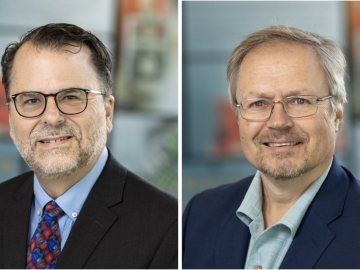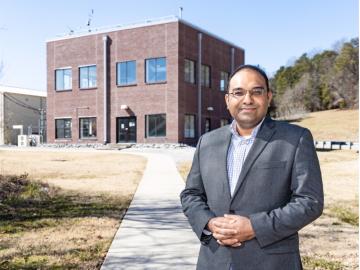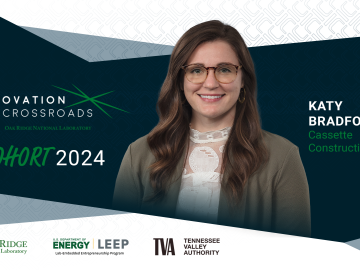
Filter News
Area of Research
- Advanced Manufacturing (8)
- Biological Systems (2)
- Biology and Environment (83)
- Building Technologies (3)
- Clean Energy (187)
- Climate and Environmental Systems (1)
- Computational Biology (2)
- Computational Engineering (2)
- Computer Science (11)
- Electricity and Smart Grid (3)
- Functional Materials for Energy (1)
- Fusion and Fission (10)
- Fusion Energy (3)
- Isotope Development and Production (1)
- Isotopes (27)
- Materials (115)
- Materials Characterization (1)
- Materials for Computing (20)
- Materials Under Extremes (1)
- National Security (31)
- Neutron Science (43)
- Nuclear Science and Technology (10)
- Quantum information Science (2)
- Sensors and Controls (1)
- Supercomputing (117)
- Transportation Systems (2)
News Topics
- (-) Artificial Intelligence (101)
- (-) Big Data (61)
- (-) Bioenergy (92)
- (-) Buildings (67)
- (-) Exascale Computing (42)
- (-) Grid (66)
- (-) Isotopes (57)
- (-) Materials Science (146)
- (-) Mercury (12)
- (-) Space Exploration (25)
- (-) Summit (59)
- (-) Transportation (99)
- 3-D Printing/Advanced Manufacturing (128)
- Advanced Reactors (34)
- Biology (101)
- Biomedical (61)
- Biotechnology (24)
- Chemical Sciences (73)
- Clean Water (31)
- Climate Change (106)
- Composites (30)
- Computer Science (198)
- Coronavirus (46)
- Critical Materials (29)
- Cybersecurity (35)
- Decarbonization (85)
- Education (5)
- Element Discovery (1)
- Emergency (2)
- Energy Storage (112)
- Environment (201)
- Fossil Energy (6)
- Frontier (45)
- Fusion (58)
- High-Performance Computing (93)
- Hydropower (11)
- Irradiation (3)
- ITER (7)
- Machine Learning (51)
- Materials (147)
- Mathematics (10)
- Microelectronics (4)
- Microscopy (51)
- Molten Salt (9)
- Nanotechnology (60)
- National Security (72)
- Net Zero (14)
- Neutron Science (137)
- Nuclear Energy (111)
- Partnerships (51)
- Physics (64)
- Polymers (33)
- Quantum Computing (37)
- Quantum Science (72)
- Renewable Energy (2)
- Security (25)
- Simulation (52)
- Software (1)
- Statistics (3)
- Sustainable Energy (130)
- Transformational Challenge Reactor (7)
Media Contacts

In a game-changing study, ORNL scientists developed a deep learning model — a type of artificial intelligence that mimics human brain function — to analyze high-speed videos of plasma plumes during a process called pulsed laser deposition.

Stephen Kowalski and Mikael Salonvaara received the Distinguished Service Award, which salutes members who have served the society with distinction in chapter, regional and society activities.

Three transportation researchers at the Department of Energy’s Oak Ridge National Laboratory have been elevated to senior member grade of the Institute of Electrical and Electronics Engineers, or IEEE.

Kashif Nawaz, distinguished researcher and section head for Building Technologies Research at the Department of Energy’s Oak Ridge National Laboratory, has been named a Fellow of the American Society of Mechanical Engineers, or ASME.

Daryl Yang is coupling his science and engineering expertise to devise new ways to measure significant changes going on in the Arctic, a region that’s warming nearly four times faster than other parts of the planet. The remote sensing technologies and modeling tools he develops and leverages for the Next-Generation Ecosystem Experiments in the Arctic project, or NGEE Arctic, help improve models of the ecosystem to better inform decision-making as the landscape changes.

Katy Bradford is on a mission to revolutionize the construction industry and is the founder of Cassette Construction, a company in the newest cohort of Innovation Crossroads, a DOE Lab-Embedded Entrepreneurship Program node at ORNL. As an Innovation Crossroads fellow, Bradford and her company will receive technical, financial and networking support to successfully advance the company’s products to the marketplace.
After retiring from Y-12, Scott Abston joined the Isotope Science and Engineering Directorate to support isotope production and work with his former manager. He now leads a team maintaining critical equipment for medical and space applications. Abston finds fulfillment in mentoring his team and is pleased with his decision to continue working.

ORNL has partnered with Western Michigan University to advance intelligent road infrastructure through the development of new chip-enabled raised pavement markers. These innovative markers transmit lane-keeping information to passing vehicles, enhancing safety and enabling smarter driving in all weather conditions.

A team led by scientists at ORNL identified and demonstrated a method to process a plant-based material called nanocellulose that reduced energy needs by a whopping 21%, using simulations on the lab’s supercomputers and follow-on analysis.

Office of Science to announce a new research and development opportunity led by ORNL to advance technologies and drive new capabilities for future supercomputers. This industry research program worth $23 million, called New Frontiers, will initiate partnerships with multiple companies to accelerate the R&D of critical technologies with renewed emphasis on energy efficiency for the next generation of post-exascale computing in the 2029 and beyond time frame.


